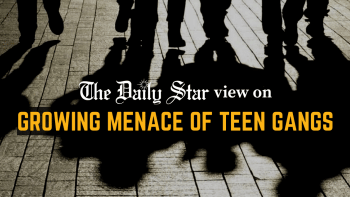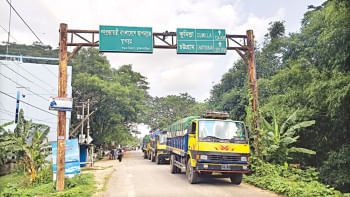The alarming rise of teen gangs

We are extremely concerned by the recent incidents in Cumilla city, where around a hundred members of "kishor (teenage) gangs" were on the streets in three neighbourhoods wielding weapons such as machetes, hockey sticks, rods, etc, while at least 15 motorcycles circled the streets making loud noises, terrifying residents and visitors who watched helplessly, according to a Prothom Alo report. This happened on Friday during admission exams of a university, which is why there were many parents and guardians of candidates waiting outside. It is disturbing that these young men felt emboldened enough to openly demonstrate with weapons in broad daylight.
This was not the first time that these gang members have shown their muscle on the streets of Cumilla city. On January 3, more than 50 members of teenage gangs staged a similar demonstration with weapons in various areas, including near Victoria College. Cocktails were also exploded, creating an atmosphere of panic. Later, police arrested some of the members.
But such arrests did not deter these gangs, as is evident from the even bigger demonstration on Friday. In fact, while police have said that they are conducting raids to catch the gang members, a few arrests here and there are not enough to stop this deep-rooted problem that has spread all over the country, including Dhaka. According to the police, there are at least 15 active "kishor gangs" in Cumilla alone. There are hundreds more all over the country, with Dhaka having the highest number. Since 2017, these gangs have been involved in at least 12 murders. They are also involved in other crimes like extortion, drug peddling, sexual harassment and sexual assault.
Such gangs have continued to thrive because of the sense of impunity and often political patronage they enjoy. Violence is a way of showing power and a way to earn the "respect" of peers. The lack of role models, financial hardship of the family, and a sense of purposelessness make gang culture all the more appealing to many youths. Youth wings of political parties, such as the Chhatra League, which became notorious for its criminal activities and violence, have been a major catalyst in the rise of teenage gang culture.
Friday's incident should be a wake-up call for us. The government must act swiftly. Police must amplify its vigilance of known hotspots with strict enforcement of juvenile justice laws. At the same time, there must be rehabilitation programmes that address the root causes of gang culture. Educational institutions must teach students basic values of empathy and kindness towards others. Parents, guardians and communities have a responsibility too, to engage with young people, create environments where children and youths are nurtured and where they develop a sense of belonging. Opportunities must be created for skills development so that these young men feel empowered and can dream of a wholesome life that does not involve violence and crime.

 For all latest news, follow The Daily Star's Google News channel.
For all latest news, follow The Daily Star's Google News channel. 






Comments